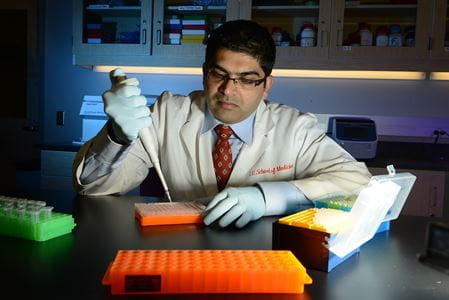Indiana University School of Medicine was recently awarded a five-year, $1.9 million grant by the National Institutes of Health (NIH) to study diabetic retinopathy (DR), a long-term, vision-threatening complication of diabetes. The grant will fund the work of scientists within the Department of Ophthalmology as they aim to discover promising treatments to assist individuals with DR in managing their condition.
Ashay Bhatwadekar, PhD, assistant professor of ophthalmology at IU School of Medicine and professor of pharmacology and toxicology at Indiana University Purdue University – Indianapolis, serves as lead investigator of the study.
“Diabetic retinopathy is an extremely complex condition,” Dr. Bhatwadekar said. “In addition to its underlying pathogenic mechanisms, an individual’s circadian rhythm – or internal clock – plays a key role in the development of this condition. Our lab is studying the impact that disturbed circadian rhythms have in the development of DR and whether the regulation of these rhythms may present a treatment strategy for the management of this condition.”
Circadian rhythms are conducive in governing several biochemical and physiological functions of the body. Disruption of these rhythms leads to insulin resistance, obesity and type 2 diabetes. The Bhatwadekar Lab research team will use the grant funding to investigate how circadian rhythm restoration corrects Müller cell dysfunction. The Müller cell, which spans across the entire retina, is instrumental in the development of DR.
“There is a gap in knowledge with regard to how a disturbed circadian rhythm influences Müller cell function,” Dr. Bhatwadekar explained. “We’re hoping to close that gap through the understanding of circadian regulatory mechanisms controlling the Kir4.1 function, which assist these cells in balancing cell potassium intake, and to evaluate how rhythm restoration corrects Müller cell dysfunction.”
According to the National Eye Institute, diabetic retinopathy is the most common diabetic eye disease and a leading cause of blindness in American adults. Approximately 7 million adults across the United States are currently living with DR.




